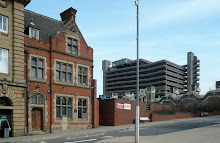

Drawing: Erased and Removed, Miles Thurlow 1998 - 2000
Empty Frames, John Clayman 2006
GOOD RIDDANCE.
3 February – 10 March 2007.
Open Fri, Sat, Sun 12-5 or by appointment
Private View 2 February 6-9pm.
Brown Sierra, John Clayman, Paul Davis, Jem Finer, Leo Fitzmaurice, Miles Thurlow, Lawrence Weiner
What happens if, rather than add-on, build-up, fill-in or replace, you get-rid-of something instead? Can getting-rid-of be constructive, progressive and forward looking, and not just destructive, nostalgic, or somehow redemptive? Can taking-away open things up, push things forward and create new lines of enquiry? Good Riddance looks to explore and expand on these thoughts and questions by inviting people to think, or think again, about the means and potential of taking-away. The exhibition brings together work by seven contemporary artists in response to the idea of taking-away and getting-rid-of as a means of making.
The artists in Good Riddance use a variety of media including sound, film and text. Most adopt a manual approach to modify, adapt and transform existing objects and forms through a process of taking-away. Through this process, things are gained rather than lost.
Brown Sierra (Paddy Collins & Pia Gambardella) is a London-based collective that works predominantly with sound and mechanical interventions. Brown Sierra’s Reduced Mechanical Sound Scapes comprise of found music box mechanisms from which teeth on the rotating drum have been filed-down to create sparse new compositions. For the exhibition, Brown Sierra will also install a wall of electrical ‘silences’.
John Clayman is a London-based artist, who, for the last two years, has been digitally manipulating black and white photographs from art textbooks. Empty Frames is a selection of iconic images of site-specific artworks made between 1955 and 1997 with the artwork painstakingly removed. What remains is a sequence of seemingly banal, but oddly familiar images presented here as a 35mm-slide show.
Paul Davis is a London-based artist, DJ, and founding-member of the ‘Beige’ art collective and the media arts company ‘Lektrolab’. For the exhibition, Davis has created a digital work from a ‘hacked’ Super Mario Brothers game cartridge. All of the game code has been removed, leaving behind an ever-changing stream of digital imagery generated by the primary data stored on the cartridge.
Jem Finer is a London-based artist and musician. His responses to Good Riddance have drawn on ideas of reduction and entropy. Finer has produced a time-lapse film that records the gradual accumulation of dust on a record over a period of months. Reduced to the original length of the recorded song, as the dust accrues the sound becomes increasingly muffled, until finally, it falls silent.
Leo Fitzmaurice is an artist based on Merseyside. His work includes floor and wall installations made from commercial packages, such as cigarette cartons and cereal boxes, from which all sections of text have been removed. Rather than being simply an anti-brand intervention, these ‘reverse collages’ invite new and surprising understandings of space, structure and identity.
Miles Thurlow is an artist based on Tyneside. He will be re-staging his piece Drawing: Erased and Removed (2000), which emerged from a laborious, process of applying/erasing graphite to/from an ink soaked board leant against a wall. Thurlow eventually abandoned this process and got-rid-of the board altogether, leaving behind grubby handprints on the wall and eraser ‘droppings’ on the floor, which unexpectedly became the work.
Lawrence Weiner is a New York-based artist. He will be participating in Good Riddance with a seminal text work – REMOVALS HALFWAY BETWEEN THE EQUATOR AND THE NORTH POLE (1969, #096) – that proposes any number of possible dimensions, scales, variables and possibilities, as well as all manner of motives and consequences.
Curated by Claire Davies and Sam Gathercole
http://www.motinternational.org
MOT
Unit 54/5th floor Regents Studios
8 Andrews Road London E8 4QN
t/f +44(0)20 7923 9561
e info@motinternational.org
Director Chris Hammond +44 (0)7931 305 104
Open Fri, Sat, Sun 12-5 or by appointment
Bethnal Green Underground
Bus 394,106,253,26,48,55,D6, D3, 8

















